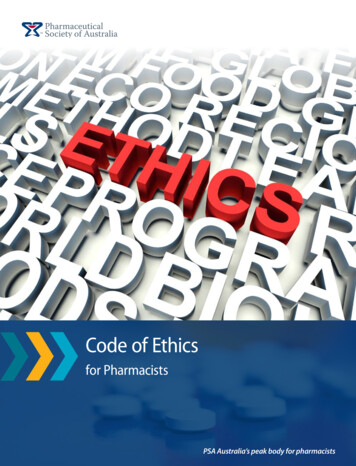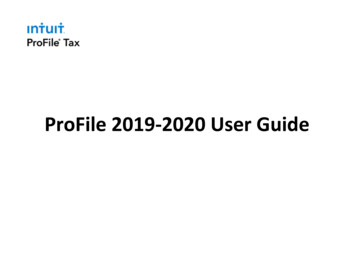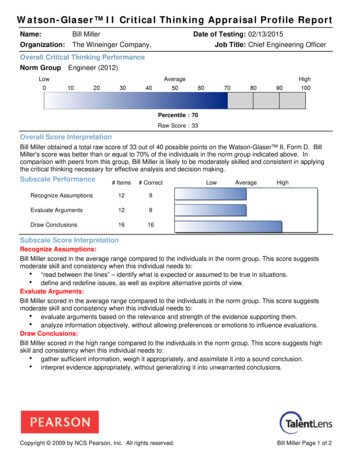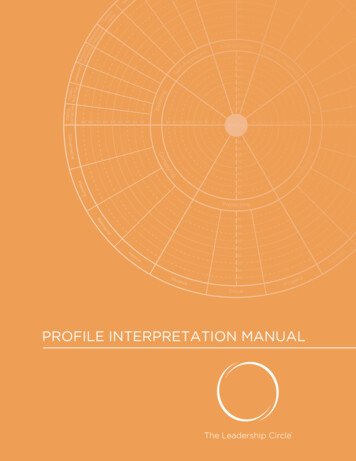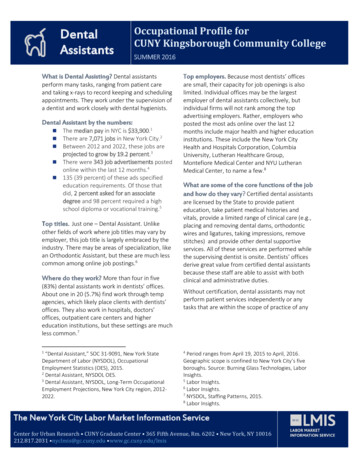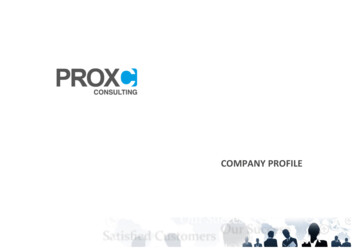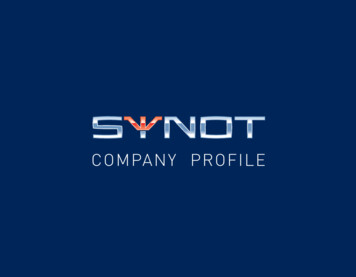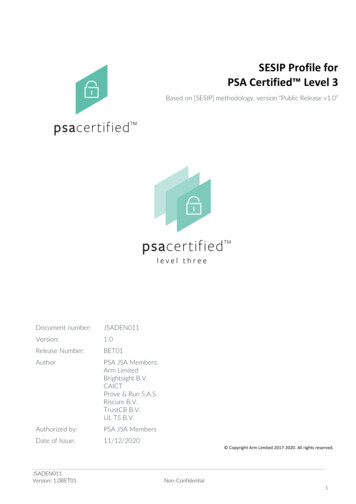
Transcription
SESIP Profile forPSA Certified Level 3Based on [SESIP] methodology, version “Public Release v1.0”level threeDocument number:JSADEN011Version:1.0Release Number:BET01AuthorPSA JSA Members:Arm LimitedBrightsight B.V.CAICTProve & Run S.A.S.Riscure B.V.TrustCB B.V.UL TS B.V.Authorized by:PSA JSA MembersDate of Issue:11/12/2020 Copyright Arm Limited 2017-2020. All rights reserved.JSADEN011Version: 1.0BET01Non-Confidential1
Contents1About this document41.1Current Status and Anticipated Changes41.2Release Information41.3References1.3.1 Normative references1.3.2 Informative references4441.4Terms and Abbreviations6Introduction92.1SESIP Profile Reference92.2Platform Reference92.3Included Guidance Documents102.4Platform Functional Overview and Description2.4.1 TOE Type2.4.2 TOE Physical Scope2.4.3 TOE Logical Scope2.4.4 Usage and Major Security Features2.4.5 Non-TOE Hardware/Software/Firmware1010101011123Security Objectives for the operational environment134Security Requirements and Implementation144.1Security Assurance Requirements4.1.1 Flaw Reporting Procedure (ALC FLR.2)14144.2Base PP Security Functional Requirements4.2.1 Verification of Platform Identity4.2.2 Verification of Platform Instance Identity4.2.3 Attestation of Platform Genuineness4.2.4 Secure Initialization of Platform4.2.5 Attestation of Platform State4.2.6 Secure Update of Platform4.2.7 Physical Attacker Resistance4.2.8 Software Attacker Resistance: Isolation of Platform (between SPE and NSPE)1414141415151515152JSADEN011Version: 1.0BET01Non-Confidential2
4.2.94.2.104.2.114.2.124.2.134.3Software Attacker Resistance: Isolation of Platform (between PSA-RoT and ApplicationRoot of Trust Services)Cryptographic OperationCryptographic Random Number GenerationCryptographic Key GenerationCryptographic KeyStore1616161617Optional Security Functional Requirements4.3.1 Audit Log Generation and Storage4.3.2 Software Attacker Resistance: Isolation of Application Parts (between each of theApplication Root of Trust services)4.3.3 Secure Debugging4.3.4 Secure Encrypted Storage (internal storage)4.3.5 Secure Storage (internal storage)4.3.6 Secure External Storage1717Additional Security Functional Requirements19Mapping and Sufficiency ADEN011Version: 1.0BET011717181818Non-Confidential3
1 About this document1.1 Current Status and Anticipated ChangesCurrent Status: Beta1.2 Release InformationThe change history table lists the changes that have been made to this 81.0ALP01Non-confidentialInitial version to be discussed with JSA members2020-10-261.0ALP02Non-confidentialUpdates discussed with JSA members2020-12-111.0BET01Non-confidentialFeedback from vendors and JSA members1.3 ReferencesThis document refers to the following documents.1.3.1 Normative referencesRefDoc NoAuthor(s)Title[PSA-EM-L2]JSADEN003JSAPSA Certified: Evaluation Methodology for PSA L2 v1.1[PSA-EM-L3]JSADEN010JSAPSA Certified: Evaluation Methodology for PSA L3 v1.0-ALP01[PSA-AM-L2]JSADEN004JSAPSA Certified Attack Method for PSA L2 v1.1[PSA-AM-L3]JSADEN008JSAPSA Certified Attack Method for PSA L3 v1.0-ALP01[PSA-PP-L2]JSADEN002JSAPSA Certified Level 2 Lightweight Protection Profile v1.1[PSA-PP-L3]JSADEN009JSAPSA Certified Level 3 Lightweight Protection Profile v1.0-ALP01[SESIP]GP FST 070GlobalPlatformSecurity Evaluation Standard for IoT Platforms (SESIP) v1.0[CEM]CCMB-201704-004Common Methodology for Information Technology SecurityEvaluation, Evaluation Methodology. Version 3.1, revision 5,April 2017.1.3.2 Informative referencesRefDoc NoAuthor(s)Title[GP-ROT]GP REQ 025GlobalPlatformRoot of Trust Definitions and Requirements, Version1.1, Public Release, June 2018JSADEN011Version: 1.0BET01Non-Confidential4
[JIL-APSC]-JHASJoint Interpretation Library – Application of AttackPotential to Smartcards v3.0 April 2019[PSA-SM]ARM DEN 0079ARMPlatform Security Architecture Security Model v1.0JSADEN011Version: 1.0BET01Non-Confidential5
1.4 Terms and AbbreviationsThis document uses the following terms and abbreviations (see PSA-SM and PSA Cert L1 V2.1 or newerquestionnaire).TermMeaningApplicationUsed in SESIP to refer to the components which are out of the scope of theevaluation. It is a synonym for Connected Application.Application Root of TrustService(s)Application specific security service(s), and so not defined by PSA. Suchservices execute in the Secure Processing Environment are required to bein Secure Partitions.Application Specific SoftwareSoftware that provides the functionality required of the specific device.This software runs in the Non-Secure Processing Environment, making useof the System Software, Application RoT Services and PSA-RoT Services.Connected ApplicationSoftware developed by an IoT vendor, implementing IoT end-user use casebased on the underlying Connected Platform. May be referred to as“Application” when there is no ambiguity.Connected PlatformCombination of hardware and software that provides a runtimeenvironment for a Connected Application. A Connected Platformimplements security features and makes security services available to theConnected Application. May be referred to as “platform” when there is noambiguity.Connected productCombination of a Connected Platform and a Connected Application that aproduct vendor puts on the market.May be referred as “product” whenthere is no ambiguity.Critical Security ParameterSecret information, with integrity and confidentiality requirements, used tomaintain device security, such as authentication data (passwords, PIN,certificates), secret cryptographic keys, etc.Evaluation LaboratoryLaboratory or facility that performs the technical review of questionnairessubmitted for Level 1 PSA certification. The list of evaluation laboratoriesparticipating to PSA Certified can be found on www.psacertified.orgHardware Unique Key (HUK)Secret and unique to the device symmetric key that must not be accessibleoutside the PSA Root of Trust. It is a Critical Security Parameter.Non-secure ProcessingEnvironment (NSPE)The processing environment that hosts the non-secure System Softwareand Application Specific Software. PSA requires the NSPE to be isolatedfrom the SPE. Isolation between partitions within the NSPE is not requiredby PSA though is encouraged where supported.In SESIP terms, the NSPE is the “application”.JSADEN011Version: 1.0BET01Non-Confidential6
PartitionThe logical boundary of a software entity with intended interaction only viadefined interfaces, but not necessarily isolated from software in otherpartitions. Note that both the NSPE and SPE may host partitions.PlatformUsed in SESIP to refer to the components which are in the scope of theevaluation. It is a synonym for Connected platform.ProductUsed by SESIP as a synonym for Connected productPSAPlatform Security ArchitecturePSA Certification BodyThe entity that receives applications for PSA security certification, issuescertificates, maintains the security certification scheme, and ensuresconsistency across all the evaluation laboratories.PSA Functional APIsPSA defined Application Programming Interfaces on which security servicescan be built. APIs defined so far include Crypto, Secure Storage andAttestation.PSA Functional API CertificationFunctional certification confirms that the device implements the PSAFunctional APIs correctly by passing the PSA Functional certification testsuites.PSA Root of Trust (PSA-RoT)The PSA defined combination of the Immutable Platform RooT of Trust andthe Updateable Platform Root of Trust, and considered to be the mosttrusted security component on the device. See [PSA-SM].Immutable Platform Root ofTrustThe minimal set of hardware, firmware and data of the PSA-RoT, which isinherently trusted because it cannot be modified following manufacture.There is no software at a deeper level that can verify that it as authenticand unmodified.Updateable Platform Root ofTrustThe firmware, software and data of the PSA-RoT that can be securelyupdated following manufacture.Platform Root of TrustService(s)PSA defined security services for use by PSA-RoT, Application RoT Service(s)and by the NSPE. Executes in the Secure Processing Environment and mayuse Trusted Subsystems. This includes the services offered by the PSAFunctional APIs.Secure PartitionA Partition in the Secure Processing Environment.Secure Processing EnvironmentPartition ManagementManagement of the execution of software in Secure Partitions. Typicalimplementations will provide scheduling and inter partition communicationmechanisms. Implementations may also enforce isolation between themanaged Secure Partitions.Secure Processing Environment(SPE)The processing environment that hosts the PSA-RoT, and any ApplicationRoT Service(s).JSADEN011Version: 1.0BET01Non-Confidential7
In SESIP terms, the SPE is the “platform”.Secure BootThe process of verifying and validating the integrity and authenticity ofupdateable firmware and software components as a pre-requisite to theirexecution. This must apply to all the firmware and software in the SPE. Itshould also apply to the first NSPE image loaded, which may extend theNSPE secure boot chain further.System SoftwareNSPE software that may comprise an Operating System or some run-timeexecutive, together with any middleware, standard stacks and libraries,chip specific device drivers, etc., but not the application specific software.Trusted subsystemA security subsystem that the PSA-RoT relies on for protection of its assets,or that implement some of its services.JSADEN011Version: 1.0BET01Non-Confidential8
2 IntroductionThis SESIP profile proposes a mapping between the security functionality defined in the PSA L3 Protection Profile[PSA-PP-L3] and the SFRs (Security Functional Requirements) listed in the SESIP catalogue [SESIP]. This profilealso includes some optional SFRs aiming to cover most of the platform use cases.The effort for performing the AVA VAN.3 activities of a standard implementation of a PSA-RoT is 35 man-days. Itis assumed for this workload that:-no additional SFRs are added in the Protection Profile;evaluation activities cannot be reused;the SFRs “Cryptographic Operation” and “Cryptographic Key Generation” include one cryptographicalgorithm.Reading guide:In the document there is guidance information aiming to facilitate reader understanding. This information can be easilyidentified as it is included in tables with a grey background:- REQ: guidance that must be considered and followed for the Security Target writing.- INFO: clarification to be considered.2.1 SESIP Profile ReferenceReferenceValuePP NameSESIP Profile for PSA Certified Level 3PP VersionV1.0ALP01Assurance ClaimSESIP Assurance Level 3 (SESIP 3)Optional and additional SFRs TBD Table 1: SESIP Profile Reference2.2 Platform ReferenceThe platform is uniquely identified by its chip (hardware) reference and its PSA defined Root of Trust (software)reference as described below. The developer declares that only the evaluated and successfully certified productsidentify in this way.ReferenceValueTOE Name TBD TOE Version TBD TOE IdentificationChip name and versionPSA-RoT name and versionTOE type TBD Table 2: Platform ReferenceJSADEN011Version: 1.0BET01Non-Confidential9
2.3 Included Guidance DocumentsThe following documents are included with the platform:ReferenceNameVersion [Ref1] Full title of the document Vx.y Table 3: Guidance DocumentsREQThe guidance must list in particular all the documents that will be provided to the evaluator for thedocumentation review, covering AGD OPE.1 and AGD PRE.1. This documentation is expected to beavailable to the customers without restrictions.2.4 Platform Functional Overview and Description2.4.1 TOE TypeThe developer must choose an appropriate TOE type. Some examples are: INFOProcessor with internal hardware isolation, such as Arm TrustZone technology, and secure memory.Processor with multiple cores where one dedicated to security.Use of a separate security processor with secure memory.Processor with roll back protected memory.As stated before, these are examples of different TOE types. The developer must fill this section basedon the evaluated product.Secure memory may be integral to the die, on a separate die within the same package or on an external packagecryptographically bound to the main chip.2.4.2 TOE Physical ScopeThe Chip hardware may be a System-on-Chip or a System-in-Package or a discrete solution all with board levelintegration.The hardware is in the scope of the security evaluation as it provides security features, such as immutablestorage or protection of JTAG, which are essential for ensuring the security of the implementation. write specific scope details, which may be a silicon chip, a PCB, 2.4.3 TOE Logical ScopeThe scope for a PSA Certified Level 3 Security evaluation, or Target of Evaluation (TOE), is the combination of thetrusted hardware and firmware components implementing a PSA-RoT with the Security Functional Requirementsstated in this document. PSA Certified Level 3 scope is identical to PSA Certified Level 2.The Chip security evaluation scope includes the following components as described in [PSA-SM]: Immutable Platform Root of Trust, for example, the Boot ROM, any root parameters, the isolationhardware, and hardware based security lifecycle management and enforcement.JSADEN011Version: 1.0BET01Non-Confidential10
Updateable Platform Root of Trust, for example, can include the Main Bootloader code, the code thatimplements the SPE Partition Management function, and the code that implements the PSA definedservices such as attestation, secure storage, and cryptography.Trusted subsystems are components that the PSA Root of Trust relies on for protection of its assets, or thatimplement some of its services, for example, a Subscriber Identification Module or a Secure Element.Figure 1: Scope of PSA Certified Level 3 complete this section with the logical scope of the evaluated product 2.4.4 Usage and Major Security FeaturesThe PP considers the following features for the purpose of PSA Level 3 security evaluation: A Secure Processing Environment (SPE) isolated by hardware mechanisms to protect critical services andrelated assets from the Non-Secure Processing Environment.A Secure Boot process to verify integrity and authenticity of executable code in a chain of trust startingfrom the Boot ROM. Related certificates are protected in integrity by hardware mechanisms.Support for Secure Storage, to protect in integrity and confidentiality sensitive assets for the SPE andrelated applications. These assets include at least the Hardware Unique Key (HUK), the PSA-RoT PublicKey (ROTPK), the Attestation key.A Security Lifecycle for the SPE, to protect the lifecycle state for the device and enforce the transitionrules between states.Cryptographic functions services for SPE and SPE applications.Support for an attestation method, for example Entity Attestation Token (according to IETFspecification). complete this section with the additional information from the evaluated product JSADEN011Version: 1.0BET01Non-Confidential11
2.4.5 Non-TOE Hardware/Software/Firmware clarify if the TOE is supplied with existing apps, Application Root of Trust Services or other components JSADEN011Version: 1.0BET01Non-Confidential12
3 Security Objectives for the operational environmentFor the platform to fulfil its security requirements, the operational environment (technical or procedural) mustfulfil the following objectives.IDDescriptionReferenceKEY MANAGEMENTCryptographic keys and certificates outside of the TOE aresubject to secure key management procedures. [Ref1] Section XTRUSTED USERSActors in charge of TOE management, for instance forsignature of firmware update, are trusted. [Ref1] Section XUNIQUE IDThe integrity and uniqueness of the unique identificationof the TOE must be provided by the TOE user during thepersonalization stage. [Ref1] Section X TBD TBD TBD Table 4: Security Objectives for the Operational EnvironmentINFOAdditional Objectives for the Environment may be added.REQThe guidance must list in particular all the documents that will be provided to the evaluator for thedocumentation review, covering AGD OPE.1 and AGD PRE.1. This documentation must be available tothe customers.REQThe integrity and uniqueness of the unique identification of the TOE should be supported by thedevelopment, production and test environment.Otherwise, if the integrity and uniqueness of the unique identification is responsibility of the TOE user,then the objective for the environment UNIQUE ID must be defined.JSADEN011Version: 1.0BET01Non-Confidential13
4 Security Requirements and Implementation4.1 Security Assurance RequirementsThe claimed assurance requirements package is SESIP3 as described in Section 5.1.4.1.1 Flaw Reporting Procedure (ALC FLR.2)In accordance with the requirement for a flaw reporting procedure (ALC FLR.2), including a process to reportflaw and generate any needed update and distribute it, the developer has defined the following procedure: Describe the procedure, including where flaws can be reported (website and/or email address), how thereported flaws are handled in a timely manner, and how an application developer/end-user is informed of theupdate. 4.2 Base PP Security Functional RequirementsAs a base, the platform fulfils the following security functional requirements:REQThe “Verification of Platform Identity” and the “Secure update of platform” requirements are explicitlylisted here, because they are mandatory in all SESIP Security Targets. Additional SFRs are then added tosuit the vendor’s objectives.For every SFR, a description of the implementation proposed in the TOE and of the way thisimplementation is assessed also needs to be included.4.2.1 Verification of Platform IdentityThe platform provides a unique identification of the platform, including all its parts and their versions.INFOThis requirement is mandatory according to [SESIP].4.2.2 Verification of Platform Instance IdentityThe platform provides a unique identification of that specific instantiation of the platform, including all its parts and theirversions.4.2.3 Attestation of Platform GenuinenessThe platform provides an attestation of the “Verification of Platform Identity” and “Verification of Platform InstanceIdentity”, in a way that cannot be cloned or changed without detection.JSADEN011Version: 1.0BET01Non-Confidential14
4.2.4 Secure Initialization of PlatformThe platform ensures its authenticity and integrity during the platform initialization. If the platform authenticityor integrity cannot be ensured, the platform will go to a state where no other operation except optionallySecure Update of Platform (with Physical Attacker Resistance) can be performed.INFOREQSecure initialization must include:-Updateable Root of Trust-Application Root of Trust (if any)-NSPE code (application and OS)If the initialization fails, restarts or at most recovery using the update mechanism may be performed. Allother functionality must not be available. The application may be used to facilitate this update, but mustnot provide any other functionality until the authenticity and integrity of the platform is reestablished.Any guidance for the application on this must be explicitly mentioned as a Security Objectives for theoperational environment, with explicit reference to where this guidance is provided.4.2.5 Attestation of Platform StateThe platform provides an attestation of the state of the platform, such that it can be determined that theplatform is in a known state.4.2.6 Secure Update of PlatformThe platform can be updated to a newer version in the field such that the integrity, authenticity andconfidentiality of the platform is maintained.INFOPSA-RoT consists of an Immutable Platform RoT and an Updateable Platform RoT.This SFR is only applicable to the updatable parts.REQThe user guidance s
PP Name SESIP Profile for PSA Certified Level 3 PP Version V1.0ALP01 Assurance Claim SESIP Assurance Level 3 (SESIP 3) Optional and additional SFRs TBD Table 1: SESIP Profile Reference 2.2 Platform Reference The platform is uniquely identified by its chip (hardwar
